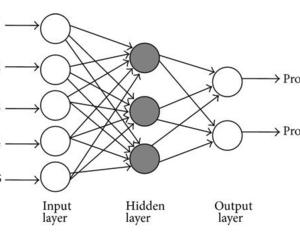1
2
3
4
5
6
7
8
9
10
11
12
13
14
15
16
17
18
19
20
21
22
23
24
25
26
27
28
29
30
31
32
33
34
35
36
37
38
39
40
41
42
43
44
45
46
47
48
49
50
51
52
53
54
55
56
57
58
59
60
61
62
63
64
65
66
67
68
69
70
71
72
73
74
75
76
77
78
79
80
81
82
83
84
85
86
87
88
89
90
91
92
93
94
95
96
97
98
99
100
101
102
103
104
105
106
107
108
109
110
111
112
113
114
115
116
117
118
119
120
121
122
123
124
125
126
127
128
129
130
131
132
133
134
135
136
137
138
139
140
141
142
143
144
145
146
147
148
149
150
151
152
153
154
155
156
157
158
159
160
161
162
|
from numpy import vstack
from pandas import read_csv
from sklearn.preprocessing import LabelEncoder
from sklearn.metrics import accuracy_score
from torch import Tensor
from torch.optim import SGD
from torch.utils.data import Dataset, DataLoader, random_split
from torch.nn import Linear, ReLU, Sigmoid, Module, BCELoss
from torch.nn.init import kaiming_uniform_, xavier_uniform_
class CSVDataset(Dataset):
def __init__(self, path):
df = read_csv(path, header=None)
self.X = df.values[:, :-1]
self.y = df.values[:, -1]
self.X = self.X.astype('float32')
self.y = LabelEncoder().fit_transform(self.y)
self.y = self.y.astype('float32')
self.y = self.y.reshape((len(self.y), 1))
def __len__(self):
return len(self.X)
def __getitem__(self, idx):
return [self.X[idx], self.y[idx]]
def get_splits(self, n_test=0.3):
test_size = round(n_test * len(self.X))
train_size = len(self.X) - test_size
return random_split(self, [train_size, test_size])
class MLP(Module):
def __init__(self, n_inputs):
super(MLP, self).__init__()
self.hidden1 = Linear(n_inputs, 10)
kaiming_uniform_(self.hidden1.weight, nonlinearity='relu')
self.act1 = ReLU()
self.hidden2 = Linear(10, 8)
kaiming_uniform_(self.hidden2.weight, nonlinearity='relu')
self.act2 = ReLU()
self.hidden3 = Linear(8, 1)
xavier_uniform_(self.hidden3.weight)
self.act3 = Sigmoid()
def forward(self, X):
X = self.hidden1(X)
X = self.act1(X)
X = self.hidden2(X)
X = self.act2(X)
X = self.hidden3(X)
X = self.act3(X)
return X
def prepare_data(path):
dataset = CSVDataset(path)
train, test = dataset.get_splits()
train_dl = DataLoader(train, batch_size=32, shuffle=True)
test_dl = DataLoader(test, batch_size=1024, shuffle=False)
return train_dl, test_dl
def train_model(train_dl, model):
criterion = BCELoss()
optimizer = SGD(model.parameters(), lr=0.01, momentum=0.9)
for epoch in range(100):
for i, (inputs, targets) in enumerate(train_dl):
optimizer.zero_grad()
yhat = model(inputs)
loss = criterion(yhat, targets)
loss.backward()
print("epoch: {}, batch: {}, loss: {}".format(epoch, i, loss.data))
optimizer.step()
def evaluate_model(test_dl, model):
predictions, actuals = [], []
for i, (inputs, targets) in enumerate(test_dl):
yhat = model(inputs)
yhat = yhat.detach().numpy()
actual = targets.numpy()
actual = actual.reshape((len(actual), 1))
yhat = yhat.round()
predictions.append(yhat)
actuals.append(actual)
predictions, actuals = vstack(predictions), vstack(actuals)
acc = accuracy_score(actuals, predictions)
return acc
def predict(row, model):
row = Tensor([row])
yhat = model(row)
yhat = yhat.detach().numpy()
return yhat
path = './data/ionosphere.csv'
train_dl, test_dl = prepare_data(path)
print(len(train_dl.dataset), len(test_dl.dataset))
model = MLP(34)
print(model)
train_model(train_dl, model)
acc = evaluate_model(test_dl, model)
print('Accuracy: %.3f' % acc)
row = [1, 0, 0.99539, -0.05889, 0.85243, 0.02306, 0.83398, -0.37708, 1, 0.03760, 0.85243, -0.17755, 0.59755, -0.44945,
0.60536, -0.38223, 0.84356, -0.38542, 0.58212, -0.32192, 0.56971, -0.29674, 0.36946, -0.47357, 0.56811, -0.51171,
0.41078, -0.46168, 0.21266, -0.34090, 0.42267, -0.54487, 0.18641, -0.45300]
yhat = predict(row, model)
print('Predicted: %.3f (class=%d)' % (yhat, yhat.round()))
|



